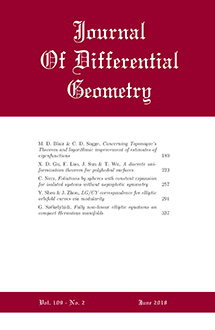Abstract
Painlevé VI equation is well known as a class of nonlinear ODEs whose solutions govern the isomonodromic deformation of a second order linear Fuchsian ODE with five regular singularities on $\mathbb{CP}^1$. We propose the question how the monodromy effects the behavior of solutions. In this paper, the second of a series devoted to this question, we study Painlevé VI equation with parameters $(\frac{(2n+1)^2}{8}, \frac{-1}{8}, \frac{1}{8}, \frac{3}{8})$ with $n \in N$. A solution $\lambda(t)$ is called unitarizable if the monodromy group of the associated linear ODE of $\lambda(t)$ is conjugated to a subgroup of the unitary group $SU(2)$. For example, any algebraic solution is unitarizable. In Part I $\href{https://doi.org/10.1016/j.geomphys.2017.01.016 }{[7]}$ we studied the special case $n = 1$. In this paper we show that
(i) Any unitarizable solution has no poles in $\mathbb{R}\setminus{0, 1}$ for all $n \in \mathbb{N}$.
(ii) For $n = 2$, there are only $3$ unitarizable solutions without poles in $\mathbb{C} \setminus \{0, 1 \}$.
(iii) For n$ = 2$, every single-valued branch of any unitarizable solution in $\mathbb{C} \setminus (-\infty, 1]$ has at most $5$ poles (this upper bound is optimal).
These results are obtained by applying the PDE result of a singular Liouville equation on flat tori and the pre-modular form $Z^{(m)}_{r,s} (\tau)$ introduced in [15, $\href{https://doi.org/10.48550/arXiv.1502.03297}{29}$]. The study of the zero structure of $Z^{(m)}_{r,s} (\tau)$ is of independent interest.
Citation
Zhijie Chen. Chang-Shou Lin. "Unitary monodromy implies the smoothness along the real axis for some Painlevé VI equation, II." J. Differential Geom. 126 (2) 555 - 582, February 2024. https://doi.org/10.4310/jdg/1712344219
Information





